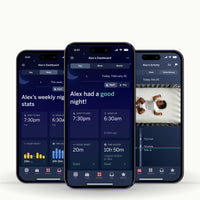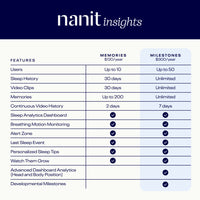Emily Chiem, Maristella Lucchini, Shambhavi Thakur, Natalie Barnett, Mirella Dapretto
SLEEP 2024
Background
Sleep problems have been associated with heightened behavioral responses to sensory stimuli in individuals with neurodevelopmental conditions. During infancy, sleep and regulatory systems undergo rapid development. However, the relationship between sleep and behavioral regulation in infants and toddlers remains unclear. In this study, we leveraged objective sleep measures to examine how parent-reported behavioral regulation to sensory stimuli relates to nighttime sleep duration.
Participants
Parent users of the Nanit baby monitor were invited to participate in the current study. Parents reported on their child’s behavioral regulatory patterns by completing the Toddler Sensory Profile 2. A behavioral dysregulation item was created based on three questions related to routines from the “General Processing” item and all questions from the “Behavioral Responses Associated with Sensory Processing” item. Objective sleep metrics from 507 children (7-18 months) were collected from the Nanit baby monitor and a computer-vision algorithm was used to compute sleep/wake states based on body position and movement. Children with at least 3 nights of sleep data were included.
Methods
Parent users of the Nanit baby monitor were invited to participate in the current study. Parents reported on their child’s behavioral regulatory patterns by completing the Toddler Sensory Profile 2. A behavioral dysregulation item was created based on three questions related to routines from the “General Processing” item and all questions from the “Behavioral Responses Associated with Sensory Processing” item. Objective sleep metrics from 507 children (7-18 months) were collected from the Nanit baby monitor and a computer-vision algorithm was used to compute sleep/wake states based on body position and movement. Children with at least 3
nights of sleep data were included.

Results
Overall, children who displayed longer nighttime sleep duration had lower behavioral dysregulation scores (r = -0.13, p = 0.003). Given the wide age range (7-18 months), we regressed out the effect of age. This relationship between behavioral regulation and sleep duration held in the whole sample even when age was added as a regressor (r = -0.15, p = 0.001), and in both males (r = -0.16, p = 0.008) and females (r = -0.13, p = 0.041) separately.

Conclusions
Our findings demonstrate that infants and toddlers with worse behavioral regulation have shorter sleep duration during the night. This suggests that either the inability to properly regulate behavioral responses to sensory stimuli disrupts nighttime sleep duration or shorter sleep duration results in altered behavioral regulation. While additional studies are needed to better understand this association, these results show that there is a clear relationship between sleep duration and behavioral regulation as early as 7 months of age, which continues into toddlerhood.

About the Researchers
The researchers included Emily Chiem, Maristella Lucchini, Shambhavi Thakur, Natalie Barnett, and Mirella Dapretto.

- Dr. Maristella Lucchini serves as Senior Clinical Researcher at Nanit. In her role, Maristella works to secure grant funding in collaboration with Nanit’s university research partners and supports the development of the company’s research collaborations around the world. Previously, Maristella served as an Assistant Research Scientist in the Division of Developmental Neuroscience, Department of Psychiatry at Columbia University Irving Medical Center where she led projects across several cohorts focusing on sleep health for pregnant and postpartum women and their children. Maristella’s research focused on underserved communities and sleep health disparities in the perinatal period. During her years as a postdoctoral researcher at Columbia University Irving Medical Center in the Department of Psychiatry, Maristella was selected to participate in the American Academy of Sleep Medicine Young Investigator Research Forum. She holds a Ph.D. in Biomedical Engineering from Politecnico di Milano.
- Shambhavi Thakur serves as Clinical Research Data Analyst at Nanit. She holds a Masters degree in Health Informatics and Life Sciences. She oversees the research collaborations with various universities and analyzes sleep data for internal as well as external studies.
- Dr. Natalie Barnett serves as VP of Clinical Research at Nanit. Natalie initiated sleep research collaborations at Nanit and in her current role, Natalie oversees collaborations with researchers at hospitals and universities around the world who use the Nanit camera to better understand pediatric sleep and leads the internal sleep and development research programs at Nanit. Natalie holds a Ph.D. in Genetics from the University of New England in Australia and a Postgraduate Certificate in Pediatric Sleep Science from the University of Western Australia. Natalie was an Assistant Professor in the Neurogenetics Unit at NYU School of Medicine prior to joining Nanit. Natalie is also the voice of Nanit's science-backed, personalized sleep tips delivered to users throughout their baby's first few years.

























